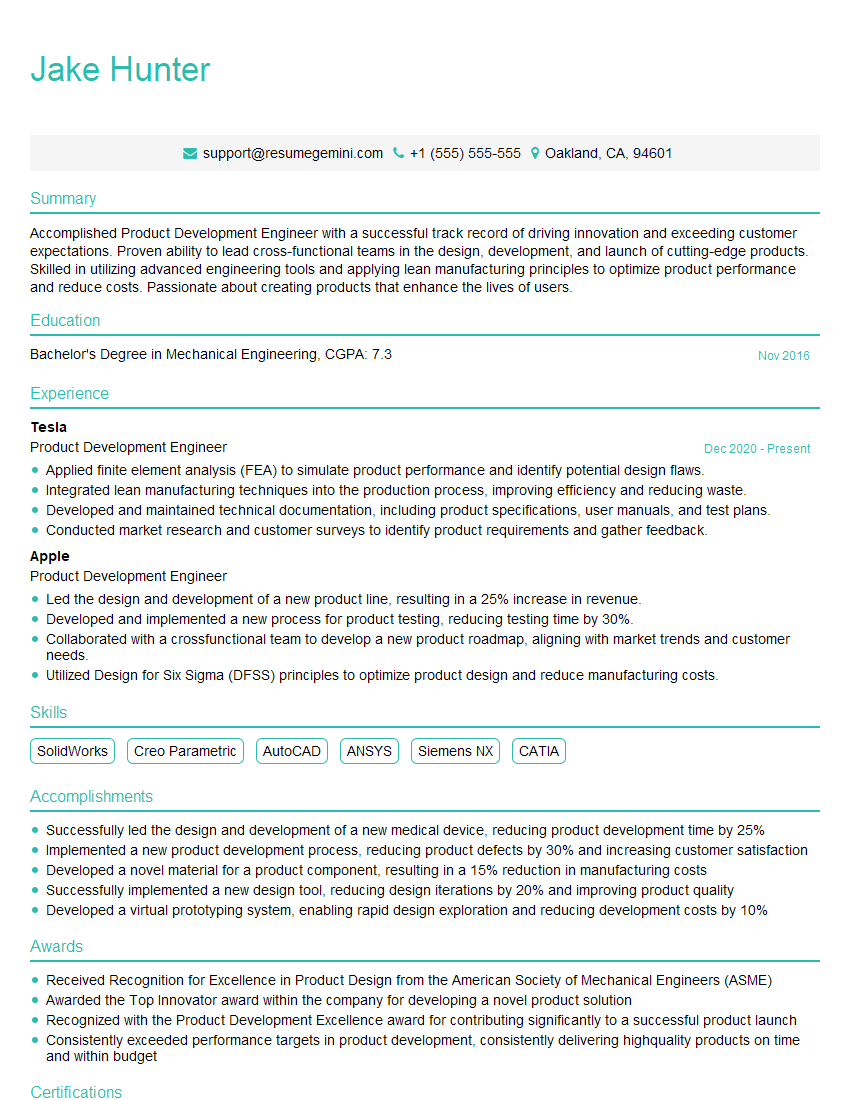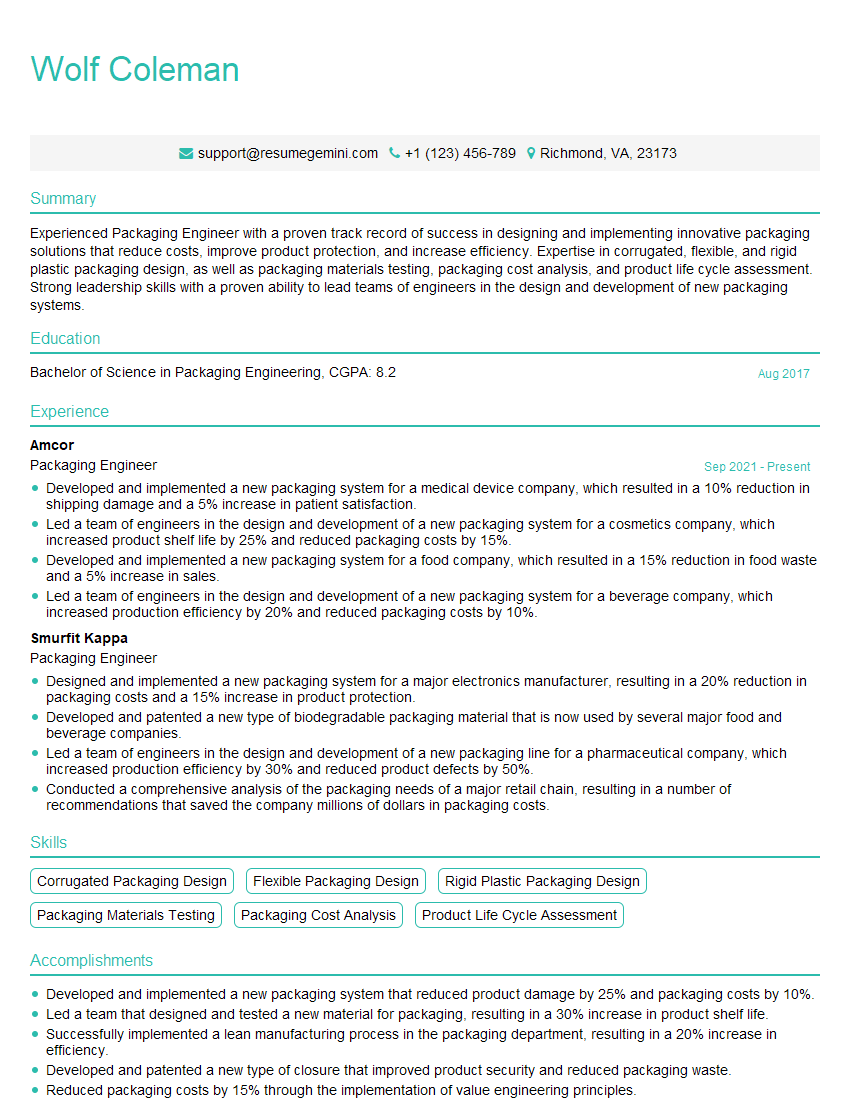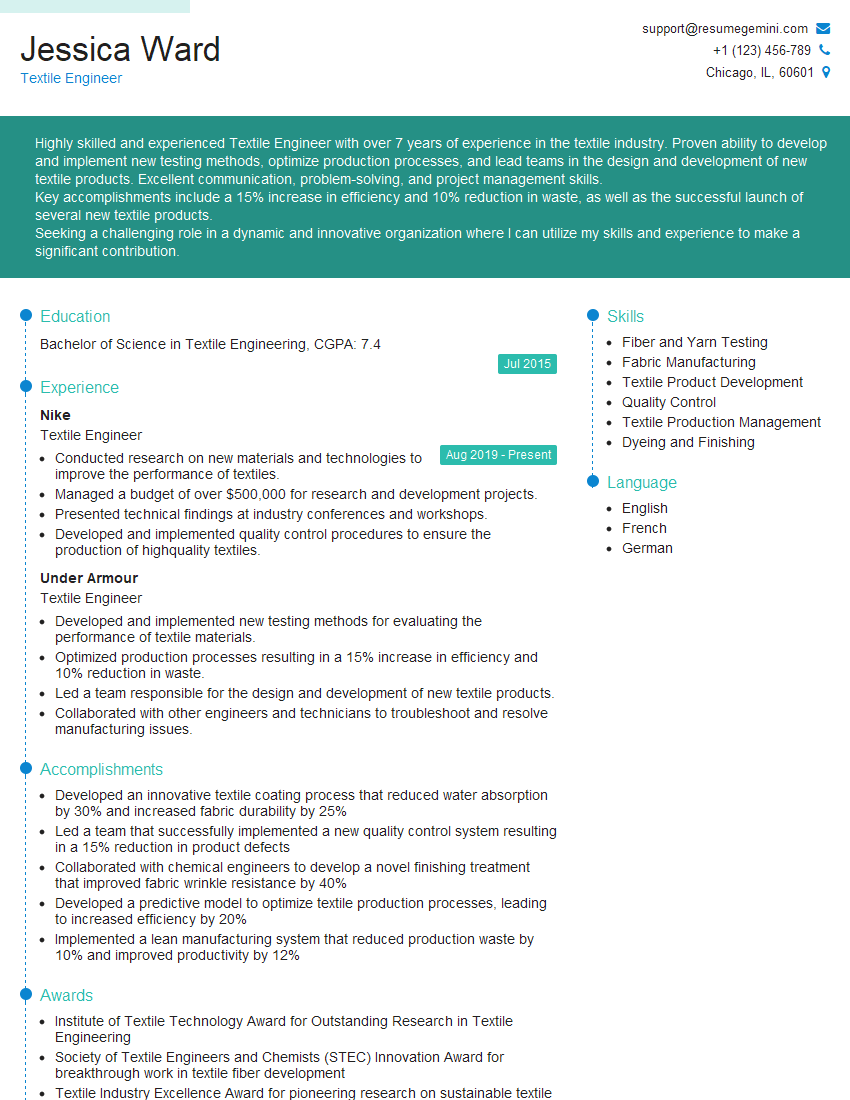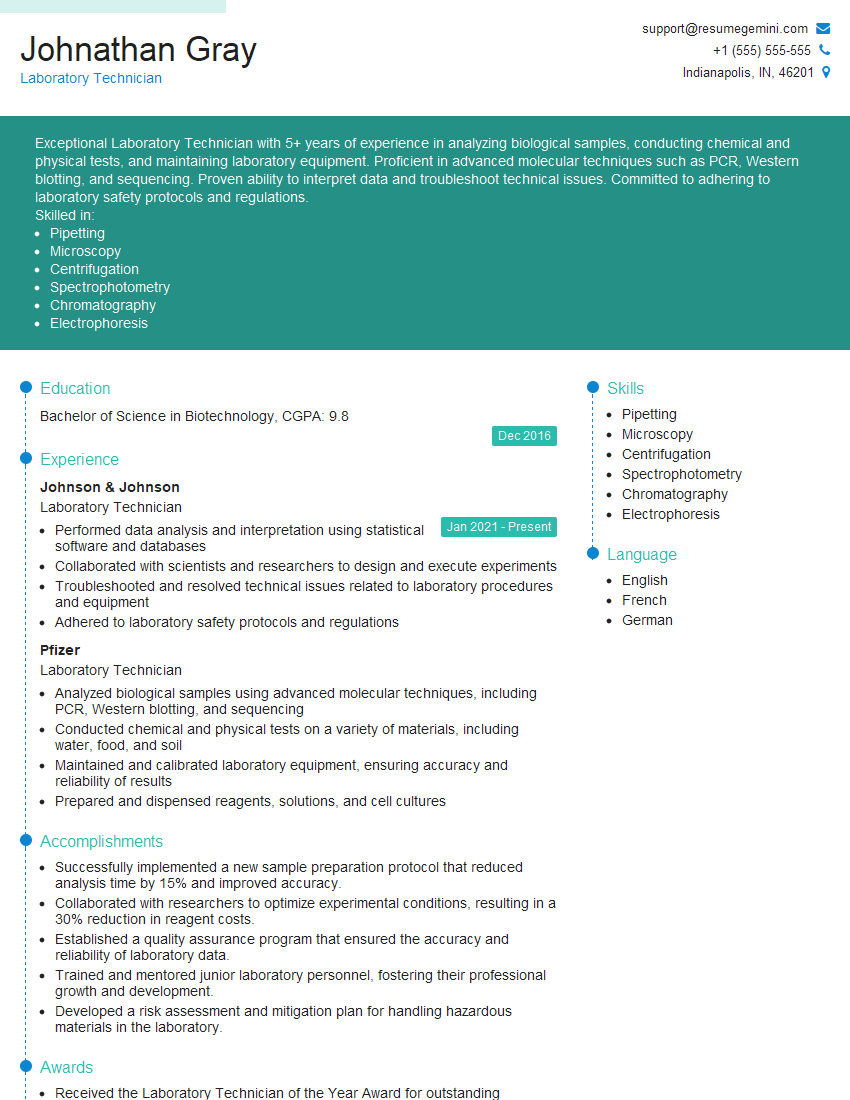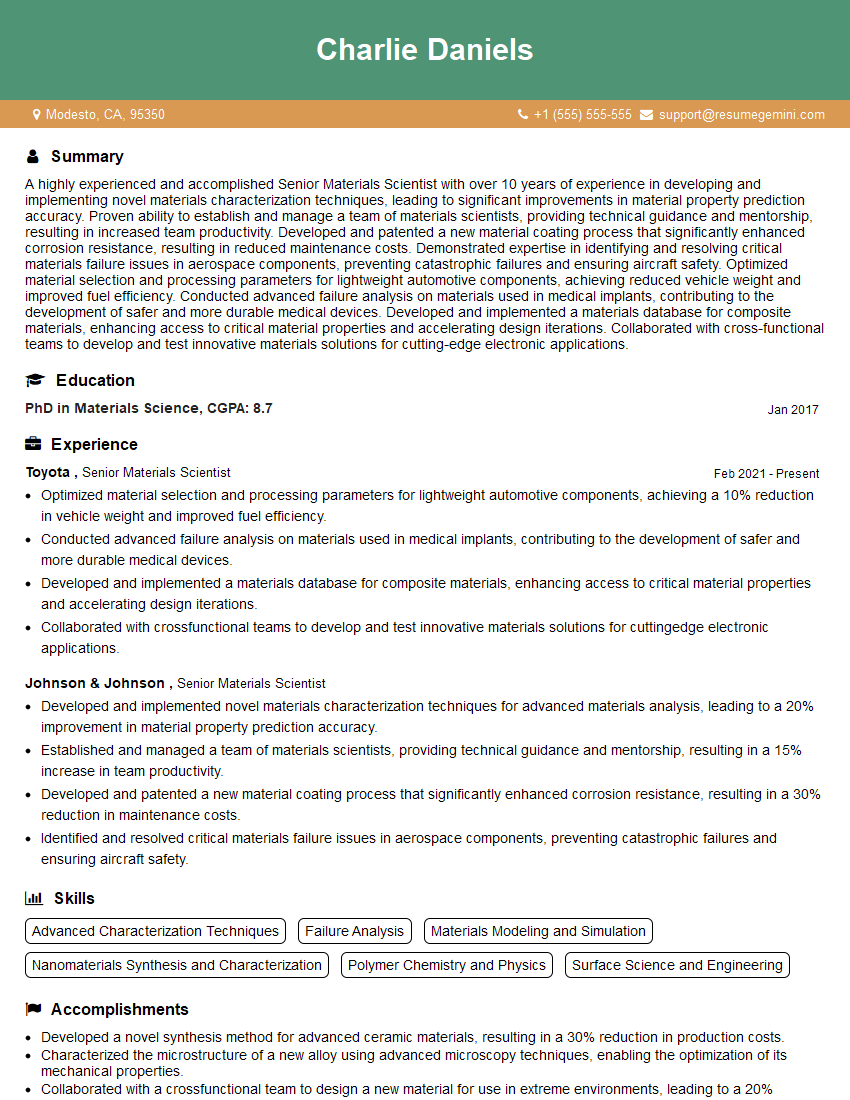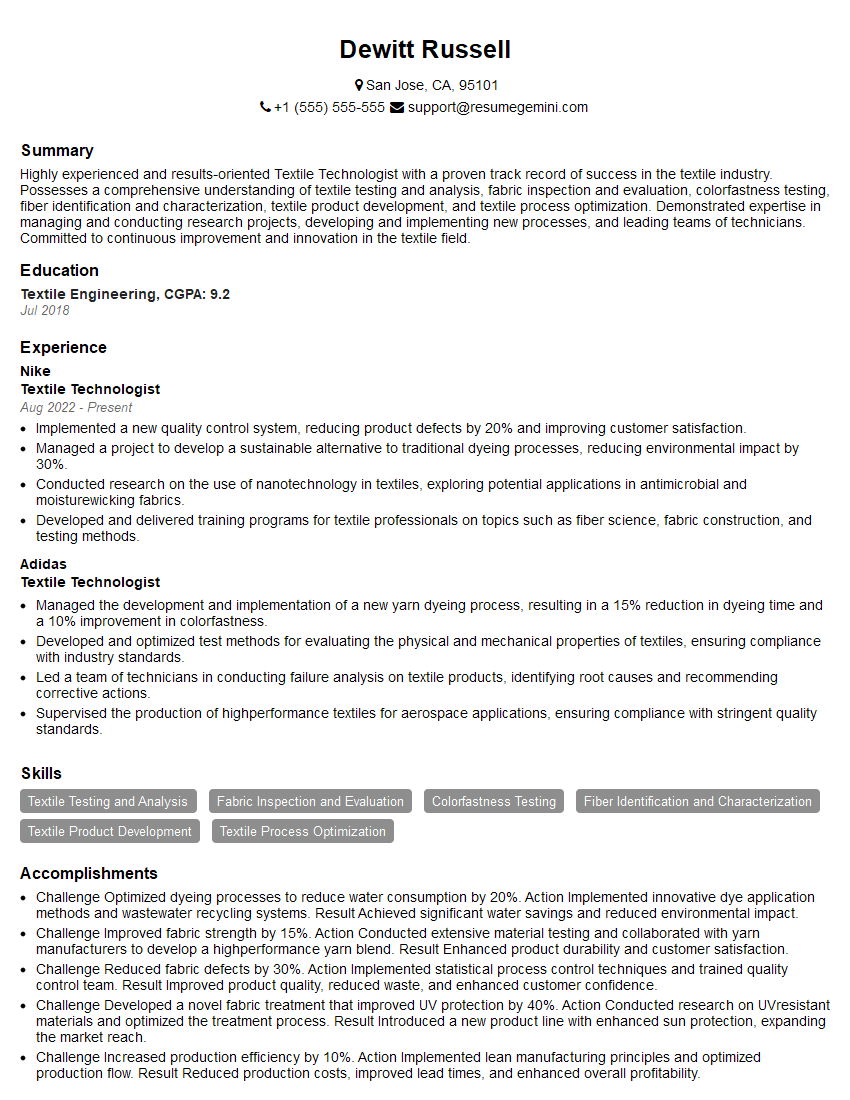Are you ready to stand out in your next interview? Understanding and preparing for Tearing Resistance Assessment interview questions is a game-changer. In this blog, we’ve compiled key questions and expert advice to help you showcase your skills with confidence and precision. Let’s get started on your journey to acing the interview.
Questions Asked in Tearing Resistance Assessment Interview
Q 1. Explain the different methods used to measure tearing resistance.
Measuring tearing resistance involves assessing a fabric’s ability to withstand the propagation of a tear. Several methods exist, each with its strengths and weaknesses. The most common methods include the Elmendorf tear strength test, the trapezoid tear test, and various customized methods depending on the specific application and material.
- Elmendorf Tear Strength Test: This is a widely used standardized method employing a pendulum-driven system to initiate and measure tear propagation.
- Trapezoid Tear Test: This method uses a specially shaped specimen and a clamping system to measure tear resistance, often preferred for thicker or stiffer materials.
- Other Methods: Less common methods involve using Instron-type tensile testers adapted to measure tearing resistance. These often involve modifying the grips and calculating tear resistance from the force-displacement curve.
Q 2. What are the limitations of each tearing resistance test method?
Each method has limitations. The Elmendorf test, while standardized, can be sensitive to specimen preparation and clamping inconsistencies, affecting reproducibility. It’s also less suitable for very thick or stiff materials. The trapezoid method, while better suited for thicker materials, is less standardized and can be more operator-dependent. Customized Instron methods, while flexible, require significant expertise in testing setup and data interpretation, and standardization is a major concern.
In general, all methods are sensitive to factors like fabric moisture content, temperature, and the presence of defects within the sample. The choice of method depends heavily on the specific material and its intended application, requiring careful consideration of the limitations.
Q 3. How does fabric construction affect tearing resistance?
Fabric construction significantly impacts tearing resistance. Think of it like building a wall – using stronger bricks (fibers) and stronger mortar (binding agents) results in a more tear-resistant structure. Several factors play a crucial role:
- Fiber Type: Stronger fibers like nylon or polyester generally provide higher tear resistance than weaker fibers like cotton or rayon.
- Yarn Twist: Higher yarn twist improves yarn strength and cohesion, increasing tear resistance.
- Fabric Structure: Tightly woven fabrics with a high thread count typically exhibit superior tear resistance compared to loosely woven fabrics.
- Weave Type: Different weaves (plain, twill, satin) have varying tear resistance properties due to differences in yarn arrangement and interlacing. Plain weave is generally less tear-resistant than twill weave.
- Finishing Treatments: Treatments like resin finishes can significantly enhance tear resistance by stiffening the fabric.
For example, a tightly woven polyester fabric will generally have much higher tearing resistance than a loosely woven cotton fabric.
Q 4. Describe the Elmendorf tear strength test procedure.
The Elmendorf tear strength test uses a pendulum apparatus. A sample with a pre-cut slit is clamped into the machine. The pendulum is released, swinging down and tearing the specimen. The energy absorbed during the tear is measured, directly related to the tear strength. The procedure is quite specific and detailed in standards like ASTM D1424. It involves precise specimen preparation (specific dimensions and slit length), proper clamping to prevent slippage, and careful observation to ensure the test is conducted correctly. The results are typically reported in grams per layer or joules.
Imagine a swinging door – the force of the swing is analogous to the pendulum’s energy, and the resistance of the door to opening is akin to the fabric’s tearing resistance.
Q 5. What is the Trapezoid tear test and when is it used?
The trapezoid tear test utilizes a trapezoid-shaped specimen clamped at the narrow end. A tearing force is applied to initiate a tear, and the force required to propagate the tear is measured. It’s particularly useful for materials that are too thick or stiff for the Elmendorf test, offering better results for these types of materials due to its different geometry. Think of it as a more robust method for thicker materials. The test is less standardized than the Elmendorf, meaning that inter-laboratory comparisons are harder to do.
Imagine using a crowbar to pry open a heavy box – the force required is analogous to the tear force in the trapezoid test.
Q 6. Explain the difference between tensile strength and tearing resistance.
Tensile strength measures a material’s resistance to a pulling force along its axis; it’s how much force is required to pull it apart in a straight line. Tearing resistance, on the other hand, assesses its resistance to the propagation of a tear already initiated; it is how much force is required to continue a tear once it’s started. Imagine pulling a rope (tensile strength) versus ripping a piece of cloth where there is already a small tear (tear resistance).
While related, they are distinct properties. A material can have high tensile strength but low tearing resistance, or vice versa. This difference is important for selecting appropriate materials for various applications.
Q 7. How do you interpret a tearing resistance test report?
Interpreting a tearing resistance test report requires understanding the test method used (Elmendorf, Trapezoid, or other) and the units reported (grams, joules, or Newtons). The report should include details on specimen preparation, testing conditions (temperature, humidity), number of specimens tested, and statistical analysis of the results (mean, standard deviation). A high average value indicates better tear resistance. The standard deviation provides information about the consistency of the results. Anomalies in individual test results should be investigated to identify potential causes (e.g., flaws in the fabric). The report should also specify the type of material tested and should always contain all the details in order to reproduce the experiment.
For example, a report might state: ‘Average tear strength: 150 g/layer (Elmendorf test), Standard Deviation: 10 g/layer’. This indicates good tear resistance with relatively consistent results.
Q 8. What factors influence the results of a tearing resistance test?
Numerous factors influence the outcome of a tearing resistance test. Think of it like trying to rip a piece of fabric – some fabrics tear easily, others don’t. This difference is due to a combination of material properties and testing conditions.
- Fiber type and properties: Stronger fibers (like nylon or polyester) generally lead to higher tearing resistance compared to weaker fibers (like cotton or linen). The fiber length and its arrangement also play a significant role.
- Yarn structure and twist: Tightly twisted yarns interlock better, resisting tearing more effectively. The yarn count (number of yarns per inch) also influences strength. A higher yarn count often means higher tear resistance.
- Fabric construction: The weave type (plain, twill, satin, etc.) significantly affects tear resistance. A tightly woven fabric will resist tearing better than a loosely woven one. The fabric’s density and weight also play a part.
- Finishing treatments: Treatments like sizing, calendaring, and resin finishes can improve tearing resistance by strengthening the fabric.
- Testing method and instrument: The specific test method used (e.g., Elmendorf or Trapezoid method) and the condition of the testing instrument will impact results. A worn-out machine can produce inaccurate results.
- Specimen preparation: How the test sample is cut and handled can affect results. Inconsistencies in sample size or the presence of defects can lead to variability.
- Environmental conditions: Temperature and humidity can affect fiber properties and thus the tearing resistance. For example, cotton’s strength is affected by moisture content.
Q 9. How do you ensure the accuracy and reliability of tearing resistance testing?
Ensuring accurate and reliable tearing resistance testing involves meticulous attention to detail at every stage. It’s like baking a cake – you need precise measurements and careful execution to achieve the desired result.
- Calibration and maintenance of equipment: Regularly calibrate the testing machine according to the manufacturer’s instructions. This ensures that the force measurements are accurate.
- Proper sample preparation: Follow standardized procedures for cutting and handling test specimens. Ensure that samples are representative of the material and free from defects.
- Controlled environmental conditions: Conduct tests in a controlled environment with specified temperature and humidity to minimize variability. This is especially crucial for materials sensitive to moisture.
- Multiple specimens: Test multiple specimens from different locations within the fabric roll. This accounts for inherent material variations and improves the statistical significance of results.
- Statistical analysis: Use appropriate statistical methods to analyze the test results, determine the mean, standard deviation, and confidence intervals. This allows for a better understanding of the variability in the data.
- Standard test methods: Adhere to established standards (like ASTM or ISO standards) to ensure consistency and comparability of results across different laboratories.
- Operator training: Ensure that personnel conducting the tests are adequately trained and experienced in operating the equipment and interpreting the results.
Q 10. What are the common units used to express tearing resistance?
Tearing resistance is usually expressed in units of force required to propagate a tear. The most common units are:
- grams-force (gf): Commonly used in older literature and some specific test methods.
- Newtons (N): The SI unit of force, increasingly preferred for its consistency.
- pounds-force (lbf): Still used in some industries, particularly in the United States.
The specific unit used will depend on the testing method and the standards followed. It’s important to always specify the units when reporting tearing resistance results to avoid ambiguity.
Q 11. Describe the relationship between fiber properties and fabric tearing resistance.
The relationship between fiber properties and fabric tearing resistance is direct and significant. Stronger, longer fibers inherently provide greater resistance to tearing. Imagine a rope made of strong fibers versus one made of weak fibers – the strong fiber rope will be much harder to break.
- Fiber strength: High fiber tensile strength translates directly to higher fabric tear strength.
- Fiber length: Longer fibers provide more inter-fiber bonding, enhancing the fabric’s overall integrity and tear resistance.
- Fiber type: Different fiber types (natural or synthetic) possess varying strength and elasticity, leading to different tearing characteristics.
- Fiber fineness: Finer fibers can pack more densely, resulting in potentially higher tear strength in certain fabric constructions.
- Fiber surface characteristics: The smoothness or roughness of the fiber surface influences the frictional forces during tearing, affecting the overall resistance.
Understanding these relationships is vital for material selection and design to achieve specific tear resistance requirements.
Q 12. How do environmental factors affect tearing resistance?
Environmental factors, primarily temperature and humidity, can significantly influence a fabric’s tearing resistance. Imagine leaving a cotton shirt out in the sun – it becomes weaker and more prone to tearing.
- Temperature: High temperatures can weaken some fibers, particularly natural fibers like cotton and wool. Low temperatures can also affect some synthetic fibers, making them more brittle.
- Humidity: Humidity affects the moisture content of fibers. Many fibers, like cotton, exhibit higher strength when slightly moist, whereas excessive moisture can weaken them. Some synthetic fibers are less affected by humidity.
- Sunlight (UV radiation): Prolonged exposure to sunlight can degrade the fibers, reducing their tearing resistance over time. This is particularly true for certain dyes and finishes.
Therefore, it’s crucial to consider and control environmental conditions during testing and in the actual application of the fabric to get accurate results and predict real-world performance.
Q 13. Explain the role of conditioning in tearing resistance testing.
Conditioning in tearing resistance testing refers to the process of bringing the fabric to a standard state of moisture and temperature before testing. This is crucial because the moisture content of a fabric significantly affects its strength and, consequently, its tearing resistance. It’s akin to preparing ingredients before baking – you need them at the right temperature and moisture level for the best result.
Standard conditioning often involves exposing the fabric to a specific temperature and relative humidity (e.g., 20°C and 65% RH) for a predetermined time until equilibrium is reached. This ensures that the test results are reproducible and comparable across different tests and laboratories. Without conditioning, inconsistencies in moisture content could lead to significant errors in the measured tearing resistance.
Q 14. What are some common causes of premature tearing failure?
Premature tearing failure, or the fabric tearing before it should based on its expected strength, can arise from several causes. It’s like a chain breaking – the weakest link determines the overall strength.
- Fabric defects: Holes, weak spots, or irregularities in the yarn or fabric structure can act as stress concentration points, initiating premature tearing. This is like a crack in a glass – it makes the glass much more prone to breaking.
- Inappropriate testing method: Using an unsuitable testing method can lead to inaccurate and misleading results. A gentle tear test is inappropriate for a strong fabric.
- Improper specimen preparation: Poorly cut or damaged specimens will give unreliable results.
- Contamination: Chemicals or other substances on the fabric can weaken its fibers.
- Equipment malfunction: A poorly maintained or calibrated testing machine can produce incorrect force measurements.
- Operator error: Incorrect handling of the specimen during testing can lead to premature tearing.
Careful attention to detail at every stage of the testing process is vital to minimize the risk of premature tearing failure and obtain accurate and reliable results.
Q 15. How do you analyze the results of a tearing resistance test to identify potential issues?
Analyzing tearing resistance test results involves more than just looking at a single number. We need to understand the context and look for trends. A low tearing resistance value, for example, might indicate a weakness in the material’s structure, potentially caused by improper manufacturing, degradation, or inherent flaws in the raw material. We compare the results against the material’s specifications, historical data, and industry standards.
For instance, if we’re testing a fabric intended for use in outdoor gear, and the tearing resistance is significantly lower than expected, we’d investigate potential reasons like UV degradation, chemical exposure, or flaws in the weaving process. Statistical analysis, such as calculating the mean, standard deviation, and range, helps identify outliers and assess the consistency of the results. Visual inspection of the tear patterns themselves can also provide valuable clues about the underlying cause of the low resistance.
We might see a consistent failure along a specific yarn direction, suggesting a weakness in the manufacturing process. Conversely, random tearing patterns might point towards issues with material heterogeneity. The overall analysis aims to pinpoint the root cause of any problems, leading to corrective actions to improve the material’s properties.
Career Expert Tips:
- Ace those interviews! Prepare effectively by reviewing the Top 50 Most Common Interview Questions on ResumeGemini.
- Navigate your job search with confidence! Explore a wide range of Career Tips on ResumeGemini. Learn about common challenges and recommendations to overcome them.
- Craft the perfect resume! Master the Art of Resume Writing with ResumeGemini’s guide. Showcase your unique qualifications and achievements effectively.
- Don’t miss out on holiday savings! Build your dream resume with ResumeGemini’s ATS optimized templates.
Q 16. Describe your experience with different types of tearing resistance testing machines.
Throughout my career, I’ve worked with a variety of tearing resistance testing machines, ranging from simple pendulum-type testers to more sophisticated Instron machines. Pendulum testers are suitable for routine testing and provide a straightforward measurement of tearing force. However, they might lack the precision and versatility of Instron machines. Instron machines, on the other hand, offer greater control over the testing parameters, allowing for more nuanced assessments of a material’s tearing behavior, including the rate at which the tear propagates.
I’ve used both constant-rate-of-extension (CRE) and constant-rate-of-load (CRL) testing methods on Instron machines, depending on the specific requirements of the test. CRE is useful when focusing on the force required to initiate and propagate a tear, while CRL better reflects the material’s response under different loading conditions. My experience also includes using specialized fixtures to adapt the machines to different sample geometries and thicknesses. Understanding the capabilities and limitations of each machine is crucial to selecting the most appropriate instrument and testing method for a specific material and application.
Q 17. How do you handle outliers or inconsistent results in a tearing resistance test?
Outliers and inconsistent results are common in tearing resistance testing. My approach is to first visually inspect the data and the samples themselves for any obvious errors. Were there any issues with sample preparation, or was the testing procedure followed correctly? If a visual inspection doesn’t reveal the cause, I’ll investigate potential systematic errors in the testing process. For example, inconsistent clamping pressure or machine calibration issues can lead to outliers.
Statistical analysis plays a crucial role. We usually start by calculating the mean and standard deviation to assess the spread of the data. Outliers that fall outside a certain range (e.g., 2 or 3 standard deviations from the mean) might be excluded, but only after careful consideration. We might then perform further analysis, such as Grubbs’ test to validate outlier removal. If the number of outliers is significant, it suggests potential issues with the testing method, sample preparation, or material homogeneity which needs investigation. In some cases, repeating the test with fresh samples is necessary to confirm the results.
Q 18. Explain the importance of proper sample preparation in tearing resistance testing.
Proper sample preparation is paramount to obtaining reliable and repeatable tearing resistance results. Imagine trying to measure the strength of a chain where some links are rusty and others are perfectly new – you wouldn’t get an accurate measurement of the chain’s overall strength! Similarly, variations in sample preparation can significantly influence tearing resistance measurements.
This includes aspects such as sample size and shape (following the specified standards), ensuring consistent thickness and avoiding any defects or damage during cutting and handling. For instance, using sharp cutting tools to prevent fiber damage, storing samples under controlled conditions to prevent degradation, and carefully conditioning samples to reach equilibrium with the testing environment are all crucial steps. Inconsistent sample preparation can introduce variability into the results and lead to inaccurate interpretations. A detailed sample preparation protocol, carefully documented and followed consistently, is essential for generating reliable results.
Q 19. What are the different standards related to tearing resistance testing?
Several standards govern tearing resistance testing, varying depending on the material type and application. For textiles, standards like ASTM D2261 and ISO 13937 are commonly used. These standards specify the test methods, sample preparation procedures, and reporting requirements. For plastics and films, standards such as ASTM D624 and ISO 6383 define the procedures. The specific standard selected depends on the material being tested and the intended use. It’s crucial to select the appropriate standard to ensure the test results are comparable and meaningful within the context of the application.
These standards ensure consistency and reliability in testing across different laboratories and manufacturers. Choosing the right standard is crucial to ensure that the test results are comparable and meaningful within the context of the application. It’s often necessary to consult with material scientists and engineers to select the most relevant and applicable standard for a given testing situation.
Q 20. How do you select the appropriate tearing resistance test method for a given material?
Selecting the appropriate tearing resistance test method depends on several factors, including the material properties, its intended application, and the available testing equipment. For example, a flexible, thin film might require a different test method than a thick, rigid sheet material. The type of tear propagation (e.g., straight tear or crescent tear) also influences the choice of method. The geometry of the sample, whether it’s a fabric, plastic film, or paper also dictates the specific testing method.
We consider the material’s thickness, its behavior under stress, and the nature of the application. A material intended for flexible packaging would require different testing conditions than a material designed for heavy-duty applications. We also need to consider the available equipment and its capabilities. The selected method must be compatible with the available testing machine and its accessories. In some cases, we might need to conduct multiple tests using different methods to fully characterize the material’s tearing behavior.
Q 21. Describe your experience with data analysis in the context of tearing resistance testing.
Data analysis is central to interpreting tearing resistance test results. Beyond basic descriptive statistics (mean, standard deviation, etc.), I regularly use more advanced statistical techniques such as ANOVA (Analysis of Variance) to compare the tearing resistance of different materials or batches, and regression analysis to model the relationship between tearing resistance and other material properties. This allows for deeper insights and helps to draw scientifically sound conclusions.
For instance, I might use regression analysis to determine how changes in the manufacturing process or material composition affect the material’s tearing resistance. Data visualization techniques like histograms and box plots are also valuable tools. They provide a clear visual representation of the data distribution, allowing for easier identification of outliers and patterns. The combination of statistical methods and visualizations provides a comprehensive understanding of the data and ultimately supports informed decision-making in material selection, process optimization, and quality control.
Q 22. How do you ensure the traceability of testing data?
Ensuring traceability in tearing resistance testing is paramount for data integrity and reliability. It’s like leaving a detailed breadcrumb trail so you can always retrace your steps and understand how a result was obtained. We achieve this through a robust system encompassing several key elements:
Unique Sample Identification: Each sample receives a unique identifier, tracked from acquisition through testing and archiving. This might involve barcodes, sequential numbering, or a combination of both. For instance, a sample might be labeled ‘Batch A-12-003’ indicating its batch, sequence, and test iteration.
Detailed Test Method Documentation: We meticulously document the specific test method used (e.g., ASTM D689), including any deviations or modifications. This includes the instrument’s calibration date, settings, and any relevant environmental conditions (temperature, humidity).
Chain of Custody: A clear chain of custody ensures the sample’s integrity remains untainted. This involves tracking who handled the sample at each stage, documenting dates, times, and any potential handling-related observations. Imagine passing a baton in a relay race – each participant signs off, maintaining continuity.
Digital Data Management: All testing data, including images and raw data files, are stored securely in a database or LIMS (Laboratory Information Management System). This allows for easy retrieval, analysis, and audit trails. The system incorporates version control to prevent accidental overwriting of data.
Regular Audits and Calibration: We conduct regular audits and calibrate our testing equipment according to standardized procedures. This ensures consistent, accurate results and compliance with relevant standards. Calibration certificates are meticulously documented and archived.
Q 23. What are the potential consequences of inaccurate tearing resistance measurements?
Inaccurate tearing resistance measurements can have serious consequences, impacting product quality, safety, and the company’s reputation. Think of building a bridge – if your calculations on the material’s strength are wrong, the consequences are catastrophic. Here’s a breakdown:
Product Failure: Incorrect measurements could lead to products that fail prematurely. For example, a garment with a lower tearing resistance than specified might rip easily during use, causing customer dissatisfaction and potential safety hazards.
Safety Concerns: In applications like protective clothing or medical devices, inaccurate measurements can compromise safety, leading to injury or infection.
Financial Losses: Incorrect measurements can result in costly rework, product recalls, and potential litigation. Imagine the cost of recalling thousands of defective products.
Reputational Damage: Repeated instances of inaccurate measurements can damage a company’s credibility and lead to loss of customer trust. It takes a long time to rebuild trust once lost.
Regulatory Non-Compliance: In many industries, meeting specific tearing resistance standards is mandatory. Failure to comply can result in fines and legal action.
Q 24. Describe a situation where you had to troubleshoot a problem during a tearing resistance test.
During a tear resistance test on a new type of composite fabric, we encountered consistently lower-than-expected results. Initially, we suspected a problem with the material itself. However, after systematically checking everything, we discovered the issue was with the test fixture’s jaws. The fabric’s unusual texture was causing slight slippage during the test, leading to inaccurate readings.
We troubleshooted this by:
Visual Inspection: Closely examining the jaws for any wear or damage.
Testing with a known material: Running a test with a material of known tear resistance to rule out instrument error.
Modifying the Jaw Surfaces: We tried using different jaw materials and adding a thin layer of high-friction material to the jaws to improve grip and reduce slippage. This required us to create a custom solution.
Re-running Tests: Once the modification was implemented, we re-ran the tests, obtaining consistent and accurate results.
The problem highlighted the importance of carefully considering the interaction between the test fixture and the material’s properties. It is a good reminder that seemingly minor issues can have a big impact on testing accuracy. Detailed documentation of the issue and its resolution was important, forming a valuable lesson learned.
Q 25. How do you communicate technical information about tearing resistance to non-technical audiences?
Communicating technical information about tearing resistance to non-technical audiences requires clear, concise language and relatable analogies. Instead of using jargon like ‘Elmendorf tear strength’, I use simple terms like ‘resistance to ripping’ or ‘how easily the material tears’.
Here’s how I approach it:
Visual Aids: I use graphs, charts, and images to illustrate data visually. A simple bar chart comparing the tearing resistance of different fabrics is far more effective than a table of numbers.
Real-world Examples: I relate tearing resistance to everyday experiences. For instance, I might say, ‘This fabric has a high tearing resistance, like a strong denim jacket that can withstand a lot of wear and tear’ or ‘Think about a paper bag – it has a low tear resistance compared to a heavy-duty canvas tote bag’.
Avoid Jargon: I avoid technical terms unless absolutely necessary. If I must use a technical term, I explain it simply.
Focus on Implications: Instead of just focusing on the numbers, I explain what those numbers mean in terms of product performance, durability, and safety.
Interactive Communication: Encourage questions and actively listen to feedback to ensure they understand the information effectively.
Q 26. What are some emerging trends in tearing resistance assessment?
Several emerging trends are shaping the field of tearing resistance assessment:
Advanced Materials: The development of new materials, such as advanced composites and bio-based materials, requires the development of new testing methods to accurately assess their tearing resistance. We must adapt our approaches to account for differences in material structure and properties.
Automation and Robotics: Automation is increasing efficiency and reducing human error in testing. Robotic systems are being implemented to perform tests more accurately and consistently, particularly for high-throughput applications.
Digital Image Correlation (DIC): DIC is a non-contact technique that can provide detailed information about strain and crack propagation during a tear test, offering a more comprehensive understanding of the material’s behavior. DIC visualizes the process, yielding greater understanding.
Artificial Intelligence (AI) and Machine Learning (ML): AI and ML are increasingly used to analyze tear test data and predict material behavior under various conditions, which increases efficiency and reduces the need for extensive experimental testing.
Focus on Sustainability: There is a growing need for more environmentally friendly testing methods, which reduces waste, energy consumption, and reliance on harmful chemicals in test preparation. We are considering more sustainable approaches, like using recycled materials in test fixtures.
Q 27. How do you stay current with the latest advancements in tearing resistance testing technology?
Staying current with advancements in tearing resistance testing technology involves a multi-pronged approach:
Professional Organizations: Active participation in professional organizations like ASTM International provides access to the latest standards, technical papers, and networking opportunities with other experts in the field.
Conferences and Workshops: Attending conferences and workshops allows for exposure to new technologies and methodologies, as well as insights into industry best practices.
Technical Publications: Regularly reading peer-reviewed journals and industry publications keeps me abreast of research findings and technological advancements.
Online Resources: I utilize online databases and search engines to access technical information and stay updated on developments in the field.
Manufacturer Websites and Training: Directly engaging with equipment manufacturers provides access to training programs and updated technical documentation on their latest instruments and technologies. This ensures I understand the capabilities of our equipment thoroughly.
Mentorship and Collaboration: Interacting with colleagues and mentors ensures a continuous exchange of knowledge and experience.
Q 28. Describe your experience working within a quality management system related to tearing resistance testing.
My experience within a quality management system (QMS) related to tearing resistance testing has been extensive. We operate under ISO 9001, which requires a systematic and documented approach to ensure consistent product quality and customer satisfaction. Our QMS includes:
Documented Procedures: Standardized operating procedures (SOPs) govern every aspect of the testing process, from sample preparation to data analysis and reporting. This ensures consistency regardless of who is conducting the tests.
Calibration and Maintenance: A rigorous calibration and maintenance program ensures the accuracy and reliability of our testing equipment. Calibration certificates and maintenance records are meticulously maintained.
Internal Audits: Regular internal audits assess the effectiveness of the QMS and identify areas for improvement. Audit findings are documented, corrective actions are implemented, and their effectiveness is verified.
Corrective and Preventive Actions (CAPA): A robust CAPA system is in place to address non-conformances, prevent recurrence, and continuously improve the quality of our testing process. Every instance of deviation is investigated, root causes are determined, corrective actions are implemented, and preventative measures are developed.
Data Integrity and Traceability: As previously mentioned, meticulous attention is paid to data integrity and traceability, which is absolutely crucial for demonstrating compliance with quality standards. We ensure we can always follow the full history of a result.
Personnel Training: All personnel involved in tearing resistance testing receive comprehensive training on the relevant test methods, SOPs, and QMS requirements. Training records are carefully maintained to ensure competency.
Working within a QMS ensures that our tearing resistance data is reliable, accurate, and traceable, building customer confidence in our results and our company’s dedication to quality.
Key Topics to Learn for Tearing Resistance Assessment Interview
- Fundamental Principles: Understanding the theoretical basis of tearing resistance, including stress concentration, crack propagation, and material failure mechanisms. Consider the differences between various testing methods and their limitations.
- Testing Methods & Standards: Familiarize yourself with common tearing resistance testing methods (e.g., trouser tear test, single rip test) and relevant industry standards (e.g., ASTM, ISO). Be prepared to discuss the advantages and disadvantages of each method.
- Material Properties & Influence: Explore how material properties such as fiber type, yarn structure, fabric construction, and finish affect tearing resistance. Understand the relationship between these properties and the test results.
- Data Analysis & Interpretation: Practice interpreting tear strength data, identifying trends, and drawing meaningful conclusions. Be able to discuss sources of error and variability in testing.
- Practical Applications: Discuss real-world applications of tearing resistance assessment across various industries (e.g., textiles, packaging, composites). Be ready to provide examples of how understanding tear resistance is crucial for product design and quality control.
- Problem-Solving Scenarios: Prepare to discuss how you would approach troubleshooting issues related to low tearing resistance in a specific product or material. This could involve identifying potential causes, proposing solutions, and suggesting further testing.
- Advanced Concepts (Optional): Depending on the seniority of the role, you might explore more advanced topics such as fracture mechanics, numerical modeling of tearing, or the use of advanced testing equipment.
Next Steps
Mastering tearing resistance assessment demonstrates a strong understanding of materials science and quality control, significantly enhancing your career prospects in numerous technical fields. To increase your chances of landing your dream job, it’s crucial to present your skills effectively. Crafting an ATS-friendly resume is key to getting your application noticed. We strongly recommend using ResumeGemini to build a professional and impactful resume that highlights your expertise in tearing resistance assessment. ResumeGemini offers examples of resumes tailored to this specific area to guide you through the process. Take advantage of these resources to showcase your qualifications and stand out from the competition.
Explore more articles
Users Rating of Our Blogs
Share Your Experience
We value your feedback! Please rate our content and share your thoughts (optional).
What Readers Say About Our Blog
Interesting Article, I liked the depth of knowledge you’ve shared.
Helpful, thanks for sharing.
Hi, I represent a social media marketing agency and liked your blog
Hi, I represent an SEO company that specialises in getting you AI citations and higher rankings on Google. I’d like to offer you a 100% free SEO audit for your website. Would you be interested?



